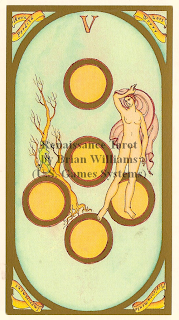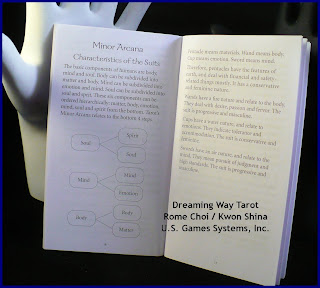A Renaissance Tarot: A Guide to the Renaissance Tarot
by Brian Williams
Size: 7" x 10"
197 pages
ISBN 10: 088079545X / 0-88079-545-X
ISBN 13: 9780880795456
Copyright 1994 by U.S. Games Systems, Inc.
DECK
Renaissance Tarot
by Brian Williams
Includes 39-page booklet
ISBN 10: 0880793074 / 0-88079-307-4
ISBN 13: 9780880793070
Size: 2-3/4" x 5"
Copyright 1987, 2005 U.S. Games Systems, Inc.
Deck and Book Set
ISBN-10: 1572810335
ISBN-13: 978-1572810334
TOP LINE (formerly Bottom Line)
Having heard many good things from many good people about the Renaissance Tarot by Brian Williams (first published in 1987), I decided the re-release of this deck and book by U.S. Games was the perfect opportunity for me to get acquainted.
As a Tarot reader who often employs Golden Dawn astrological associations, I am intrigued by the astrological associations for the Court cards in this deck. For example, the Knight of Staves is linked with Gemini, the Page of Swords with Sagittarius, the Knight of Cups with Scorpio, and the Page of Coins with Capricorn. I will enjoy exploring this aspect of the deck. As you may be able to tell from what I just wrote, this deck associates Staves with Air and Swords with Fire.
The images on the Pips strike me as being difficult to interpret at an intuitive level. For example, on the Five of Coins we are told that the scene refers to Demeter revoking her gift of fertility to the world, bringing drought and frozen ground. A cruel little boy taunts her, and she turns him into a lizard. Now that I have read the LWB, I can see where this relates to the traditional interpretation of the Five of Coins (Pentacles), but I think a fair amount of study will be needed before I can read the Pips in this deck with any degree of confidence.
As an eternal student (Sagittarius Sun), I am looking forward to reading the book A Renaissance Tarot from cover to cover, probably highlighting the most interesting passages. Based on everything I have read about Brian Williams, I believe I would have liked him very much.
[THE PUBLISHER'S] PRODUCT SUMMARY
Deck: "Through the exquisite artwork of Brian Williams, Renaissance Tarot connects traditional tarot symbology to the splendor of European Renaissance culture and classical mythology. The 22 Major Arcana cards feature the Olympian deities and demi-gods of antiquity. Card titles are in English and Italian. In the booklet, also by classics scholar Brian Williams, each card description identifies both the Greek and Roman deity as well as his related attributes. For example, the Fool is associated with Dionysus/Bacchus and the Magician with Hermes/Mercury. The four suits in the Minor Arcana are represented by four classical myth cycles with an interlocking system of planets, constellations, seasons, and elements. Swords relate to Achilles; Staves to Hercules; Cups to Cupid and Pysche; and Coins to Persephone. The great cities of Renaissance Italy are represented in the court cards. The back design of Renaissance Tarot features a mandala incorporating symbols of the four suits and the four elements. Brian Williams artfully weaves together a rich tapestry of Renaissance imagery."
Book: "A Renaissance Tarot by Brian Williams takes the reader on a journey through the symbolic landscape of the tarot. This heavily illustrated guide explores how tarot cards are woven into the fabric of European culture, while providing both the beginner and the adept with a complete guide to the cards, their meanings and uses."
THE AUTHOR
Brian Williams, who passed away in April 2002, was an artist, author, and tarot expert, with a keen appreciation for the imagery and iconography of the Italian Renaissance.
A Renaissance scholar as well as an artist, Williams wrote several books on tarot symbolism and also designed several tarot decks including the Renaissance Tarot, POMO Tarot, Minchiate Tarot, and Ship Of Fools Tarot, plus the Angel Journey cards and the book to Michael Goepferd’s Light and Shadow Tarot.
In the preface to A Renaissance Tarot, Williams recalls, "I scribbled constantly from an early age, having inherited some of my mother's talent for drawing. . . my favorite picture books were the glossy, oversized "coffee table" art books in the family library. Castles and ancient cities, mythical gods and monsters fired my imagination."
A Brian Williams Tribute Page can be found at this link: http://www.tarotpassages.com/brian.htm
BASIC INFORMATION / APPEARANCE, SIZE, QUALITY / ART
Deck
The cards in this deck are printed on sturdy card stock with a glossy finish. They measure 2-3/4" x 5". Within white borders, each card has a gold border that forms an arch at the top on most of the Majors and Courts. On the Pips and some of the Majors, there is a gold oval within the gold border, encircling the image on the card. On many cards, tiny illustrations occupy the corners, within the gold border. Card titles are in both English and Italian.
Images on the Courts and Pips are painted primarily in pastels against a pale yellow, blue, rose, or green background. The Majors typically incorporate bolder, brighter color.
The back design is gray-beige in color. As described by Brian Williams, the back design of the cards "sets out the four-fold cosmology. Signs and symbols of the four suits are at each corner. . . Enveloping and connecting everything in the design is an enlaced network of triple circles. . . The mandala of the back design can be read outward from the center as a version of the Pythagorean Tetrad."
Book: A Renaissance Tarot (A Guide to the Renaissance Tarot) is a 197-page paperback measuring 7 x 10 inches. Text is interspersed with a large number of black-and-white illustrations. The layout is clean and inviting, which is helpful because a huge quantity of information is presented in this book. This is not a "quick read."
DETAILS / COMMENTS
Deck:
Major Arcana: The Trumps in this deck depict all the gods and goddesses of Olympus as "guardian deities." For example, Dionysus (or Bacchus to the Romans) stands in the upper right corner of The Fool card; Poseidon (Neptune) accompanies The Hierophant; Artemis (Diana) stands in the right corner of The Moon.
Courts: The art and architecture of an Italian city is featured by suit on the Court Cards: Swords represent Milan, Staves represent Florence, Cups represent Venice, and Coins represent Rome.
Pips: The pip cards of this deck are similar to Marseille style, featuring the suit symbols that correspond to the number of that card. There are human beings on many of the pips, but they are often merely "posing," not acting out the meaning of the card.
The numbered cards are organized under four great myth cycles: Eros (Cupid) and Psyche for the Cups; Persephone (Proserpine) and Hades for the Coins; Herakles (Hercules) for the Staves or Wands; and Achilles and the Trojan War for Swords.
In the suit of Swords, the hilts on the swords are different from pip to pip. Coins suit markers are pale, golden-tan circles ringed by a heavy brown rim and thin russet lines. Cups suit markers have the same color scheme. Staves resemble the living tree from which they were hewn.
The 39-page "Little White Book" (LWB) offers an "Introduction to Tarot", information about the Presentation Card included in this deck, information about the Back Design, and a discussion of each card, including Divinatory Meanings and Reverse Meanings. At the end of the LWB is a discussion about The Ten-Card Spread (Celtic Cross). A blank page is provided for Notes.
Book: A Renaissance Tarot is organized as follows:
- Preface
- Introduction
- Chapter 1: A World of Allegory (The Macrocosm, The Microcosm, Divine Symmetry)
- Chapter 2: The History of the Tarot
- Chapter 3: The Major Arcana
- Chapter 4: The Minor Arcana
- Chapter 5: Reading the Cards
- Bibliography
- Index
- List of Illustrations
As Brian Williams writes in the Introduction, "This book may be used as a guide to any deck of tarot cards, but it especially accompanies the Renaissance Tarot by Brian Williams." Each card from the Renaissance Tarot is compared with many other tarot images. The discussion of each Major begins with a quotation from Shakespeare.
This book offers a wealth of tarot history and art history through text, art, and quotations. Williams discusses hand-painted cards, engraved cards, woodcut decks, the Tarot of Marseilles, the game of Tarot, and occultism and fortune-telling.
In accordance with the FTC Guidelines for blogging and endorsements, I hereby disclose that this product was provided by the publisher for free. Other than the occasional review copy, I receive no monetary or in-kind compensation for my reviews. The substance of my reviews is not influenced by whether I do or do not receive a review copy.




























